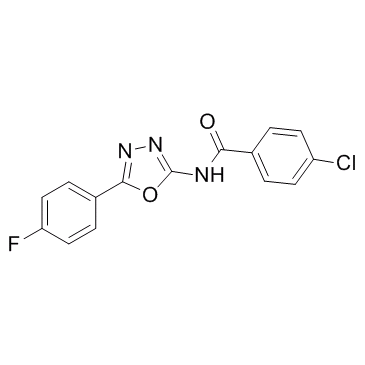| Cas No.: | 865285-29-6 |
| Chemical Name: | 3-chloro-N-(1-propyl-1H-tetrazol-5-yl)benzamide |
| Synonyms: | KKL 35;KKL35 |
| SMILES: | O=C(C1C=CC(Cl)=CC=1)NC1OC(C2C=CC(F)=CC=2)=NN=1 |
| Formula: | C15H9ClFN3O2 |
| M.Wt: | 317.7 |
| Purity: | >98% |
| Sotrage: | 2 years -20°C Powder, 2 weeks 4°C in DMSO, 6 months -80°C in DMSO |
| Publication: | [1]. Ramadoss NS, et al. Small molecule inhibitors of trans-translation have broad-spectrum antibiotic activity. Proc Natl Acad Sci U S A. 2013 Jun 18;110(25):10282-7. |
| Description: | KKL-35 is a trans-translation tagging reaction inhibitor with an IC50 of 0.9 µM. |
| Target: | IC50: 0.9 µM (trans-translation tagging reaction)[1] |
| In Vivo: | Evidence suggest that the in vivo effects of KKL-35 are caused by inhibition of the release of nonstop translation complexes by trans-translation. KKL-35 inhibits trans-translation and prevents growth of S. flexneri strains that require trans-translation. The correlation between inhibition of trans-translation and growth is supported by genetic and pharmacological experiments showing that alternative mechanisms to release nonstop translation complexes relieve the growth suppression of KKL-35[1]. |
| In Vitro: | KKL-35 exhibits broad-spectrum antibiotic activity. KKL-35 prevents growth of B. anthracis and M. smegmatis with minimum inhibitory concentration (MIC) values of less than 6 µM. KKL-35 inhibit trans-translation at some step before proteolysis of tagged proteins. KKL-35 inhibits tagging of DHFR-ns. A large amount of untagged DHFR is produced in reactions with the highest concentrations of KKL-35, indicating that KKL-35 does not inhibit translation. KKL-35 prevents growth of WT S. flexneri with a MIC of 6 µM, and addition of KKL-35 to a growing culture of S. flexneri stops growth. In an S. flexneri strain expressing ArfA and deleted for ssrA, addition of KKL-35 has little effect on viability or growth rate. KKL-35 inhibits the growth of E. coli ∆tolC, which is deficient in small molecule efflux, with an MIC of 0.3 µM[1]. |
| References: | [1]. Ramadoss NS, et al. Small molecule inhibitors of trans-translation have broad-spectrum antibiotic activity. Proc Natl Acad Sci U S A. 2013 Jun 18;110(25):10282-7. |

 To enhance service speed and avoid tariff delays, we've opened a US warehouse. All US orders ship directly from our US facility.
To enhance service speed and avoid tariff delays, we've opened a US warehouse. All US orders ship directly from our US facility.




















